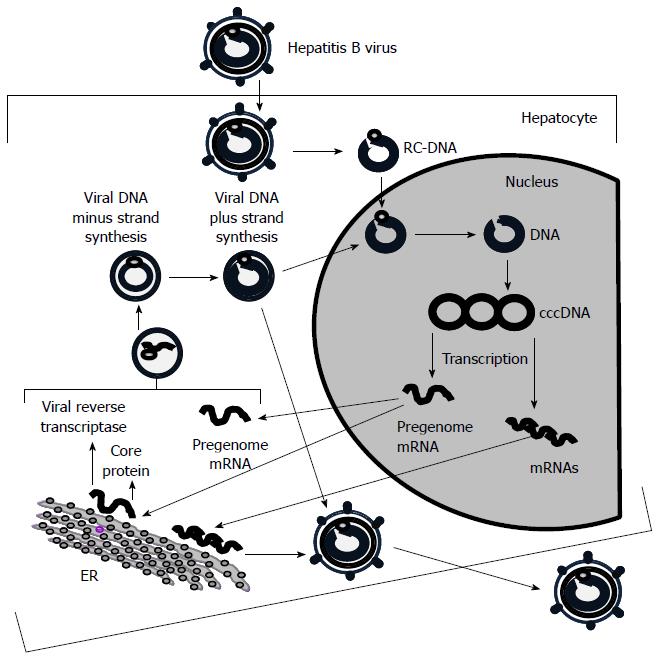Copyright
©2014 Baishideng Publishing Group Inc.
World J Gastroenterol. Oct 21, 2014; 20(39): 14156-14171
Published online Oct 21, 2014. doi: 10.3748/wjg.v20.i39.14156
Published online Oct 21, 2014. doi: 10.3748/wjg.v20.i39.14156
Figure 1 Hepatitis B virus DNA replication.
Hepatitis B virus (HBV) penetration inside a hepatocyte occurs via interaction of envelope proteins with the cell receptors. Viral DNA release from the nucleocapsid with the help of the cellular enzymes takes place in the cytoplasm. After that the viral DNA gets into the nucleus and forms a circular structure-covalently closed circular DNA (cccDNA) which by transcription contributes to the formation of pregenomic RNA and three more mRNAs. Pregenomic RNA leaves the nucleus, gets into endoplasmic reticulum (ER) and serves as a template for synthesis of the core protein and the viral reverse transcriptase. The newly synthesized proteins in combination with free molecules of pregenomic RNA form the nucleocapsid. In the nucleocapsid with help of the reverse transcriptase and the pregenomic RNA as template, the minus strand is synthesized, which later serves as a template for the formation of the plus strand. The formed virus nucleocapsid can either take part in amplication of the viral genome or reach the ER and associate with precore protein and envelope proteins coded by other (non-pregenomic) mRNAs to form a mature virion, then leave the hepatocyte.
- Citation: Balmasova IP, Yushchuk ND, Mynbaev OA, Alla NR, Malova ES, Shi Z, Gao CL. Immunopathogenesis of chronic hepatitis B. World J Gastroenterol 2014; 20(39): 14156-14171
- URL: https://www.wjgnet.com/1007-9327/full/v20/i39/14156.htm
- DOI: https://dx.doi.org/10.3748/wjg.v20.i39.14156









